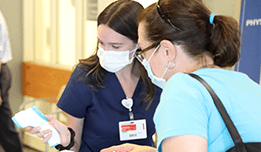Top of the pageCheck Your Symptoms
Rectal Problems
Overview
Rectal problems are common. Almost everyone will have some rectal itching, pain, or bleeding at some time. These problems are often minor. They may go away on their own or with home treatment.
Rectal itching
Rectal itching (pruritus) usually isn't a sign of a serious disease. At first, the skin of the anal area, Opens dialog may look red. Itching and scratching may make the skin become thickened and white. Common causes of rectal itching include:
- Poor cleaning of the area after a bowel movement. Itching and discomfort may happen when pieces of stool become trapped in skin folds around the anus, Opens dialog.
- Medicines, especially ones that cause diarrhea or constipation. Antibiotics, Opens dialog are one example.
- Cleaning of the anus with very hot water and strong soaps. The anal area is normally oily. This oil barrier protects against the irritation of bowel movements. Repeated cleaning or showering will remove these oils. It can lead to a cycle of itching and scratching that can be hard to stop.
- The use of scented toilet paper, scented soap, or ointments (such as those that contain benzocaine).
- A dry skin condition that affects the whole body. This condition is more common in older adults.
- Hemorrhoids, Opens dialog. These are enlarged veins near the lower end of the rectum, Opens dialog or outside the anus.
- An infection of the anus or rectum. It may be caused by viruses (such as genital warts, Opens dialog) or bacteria, Opens dialog. Or it may be caused by pinworms, Opens dialog, scabies, Opens dialog, fungus, yeast, or parasites. Some infections are passed on by animals. Pinworms are the most common cause of anal itching in children. An infection you get from an animal is called a zoonosis (say "zoh-uh-NOH-sus"). Some infections can seem mild, but others can be quite serious. You can get an infection from a pet, a farm animal, or a petting zoo.
- Certain foods. These foods may include coffee, tea, cola, alcoholic drinks, chocolate, tomatoes, spicy foods, and large amounts of vitamin C.
- Some people get infections while traveling that can cause rectal itching and other problems. If you are planning to travel to another country, see a doctor several months before you leave. It will give you time to get vaccines (immunizations) that you may need.
Rectal pain
Rectal pain may be caused by diarrhea, constipation, or anal itching and scratching. Rectal pain caused by these conditions usually goes away when the problem clears up.
Other less common causes of rectal pain include:
- Enlarged, swollen veins in the anus (hemorrhoids).
- Structural problems, such as anal fissures and fistulas, Opens dialog or rectal prolapse, Opens dialog.
- Infection. Examples include sexually transmitted infections, Opens dialog, prostate infections, Opens dialog, an abscess, Opens dialog, and pilonidal cysts, Opens dialog.
- Injury from foreign body insertion, anal intercourse, or abuse.
- Diseases, such as cirrhosis of the liver, Opens dialog, diabetes, lymphoma, Opens dialog, Crohn's disease, Opens dialog, or ulcerative colitis, Opens dialog.
- Cancer of the rectum or the prostate or skin cancers, such as squamous cell cancer, Opens dialog and Bowen's disease, Opens dialog.
- Previous treatment, such as surgery or radiation therapy to the rectum or pelvis.
- Rectal spasms, Opens dialog (proctalgia fugax).
Rectal bleeding
Many people have small amounts of rectal bleeding. Irritation of the rectum from diarrhea or constipation, a small hemorrhoid, or an anal fissure can cause a small amount of bright red blood. You may see the bright blood on the surface of the stool or on the toilet paper. Hemorrhoids and anal fissures usually occur after straining during a bowel movement because of constipation. This type of bleeding can cause pain during a bowel movement. It doesn't make the toilet water bloody. It isn't serious if there is only a small amount of blood and the bleeding stops when the diarrhea or constipation stops. Home treatment is usually all that you need.
Bleeding can happen anywhere in the digestive tract. The blood is digested as it moves through the digestive tract. The longer it takes the blood to move through the tract, the less it will look like blood. Often blood that is caused by bleeding in the stomach will look black and tarry. A tarry stool has a black, shiny, sticky appearance. It looks like tar on a road. Blood that has moved quickly through the digestive tract or that starts near the rectum may look red or dark red.
Certain medicines and foods can affect the color of the stool. Diarrhea medicines (such as Pepto-Bismol) and iron tablets can make the stool black. Eating lots of beets may turn the stool red. Eating foods with black or dark blue food coloring can turn the stool black.
The medical assessment of symptoms is based on the body parts you have.
- If you are transgender or nonbinary, choose the sex that matches the body parts (such as ovaries, testes, prostate, breasts, penis, or vagina) you now have in the area where you are having symptoms.
- If your symptoms aren’t related to those organs, you can choose the gender you identify with.
- If you have some organs of both sexes, you may need to go through this triage tool twice (once as "male" and once as "female"). This will make sure that the tool asks the right questions for you.
Many things can affect how your body responds to a symptom and what kind of care you may need. These include:
- Your age. Babies and older adults tend to get sicker quicker.
- Your overall health. If you have a condition such as diabetes, HIV, cancer, or heart disease, you may need to pay closer attention to certain symptoms and seek care sooner.
- Medicines you take. Certain medicines, such as blood thinners (anticoagulants), medicines that suppress the immune system like steroids or chemotherapy, herbal remedies, or supplements can cause symptoms or make them worse.
- Recent health events, such as surgery or injury. These kinds of events can cause symptoms afterwards or make them more serious.
- Your health habits and lifestyle, such as eating and exercise habits, smoking, alcohol or drug use, sexual history, and travel.
Try Home Treatment
You have answered all the questions. Based on your answers, you may be able to take care of this problem at home.
- Try home treatment to relieve the symptoms.
- Call your doctor if symptoms get worse or you have any concerns (for example, if symptoms are not getting better as you would expect). You may need care sooner.
Blood in the stool can come from anywhere in the digestive tract, such as the stomach or intestines. Depending on where the blood is coming from and how fast it is moving, it may be bright red, reddish brown, or black like tar.
A little bit of bright red blood on the stool or on the toilet paper is often caused by mild irritation of the rectum. For example, this can happen if you have to strain hard to pass a stool or if you have a hemorrhoid.
A large amount of blood in the stool may mean a more serious problem is present. For example, if there is a lot of blood in the stool, not just on the surface, you may need to call your doctor right away. If there are just a few drops on the stool or in the diaper, you may need to let your doctor know today to discuss your symptoms. Black stools may mean you have blood in the digestive tract that may need treatment right away, or may go away on its own.
Certain medicines and foods can affect the color of stool. Diarrhea medicines (such as Pepto-Bismol) and iron tablets can make the stool black. Eating lots of beets may turn the stool red. Eating foods with black or dark blue food coloring can turn the stool black.
If you take aspirin or some other medicine (called a blood thinner) that prevents blood clots, it can cause some blood in your stools. If you take a blood thinner and have ongoing blood in your stools, call your doctor to discuss your symptoms.
Rectal itching is most often caused by dry or irritated skin in the rectal area. It can also be a sign of pinworms, especially in children.
Itching may be more serious if it occurs with a rash or if it does not improve with home treatment.
Home treatment for rectal itching includes things like:
- Keeping the area clean and dry.
- Washing the area with water several times a day and after bowel movements.
- Sitting in a few inches of warm water in a bathtub.
- Wearing loose-fitting cotton underwear.
- Using a nonprescription hydrocortisone (1%) cream on the area.
Pain in adults and older children
- Severe pain (8 to 10): The pain is so bad that you can't stand it for more than a few hours, can't sleep, and can't do anything else except focus on the pain.
- Moderate pain (5 to 7): The pain is bad enough to disrupt your normal activities and your sleep, but you can tolerate it for hours or days. Moderate can also mean pain that comes and goes even if it's severe when it's there.
- Mild pain (1 to 4): You notice the pain, but it is not bad enough to disrupt your sleep or activities.
Pain in children under 3 years
It can be hard to tell how much pain a baby or toddler is in.
- Severe pain (8 to 10): The pain is so bad that the baby cannot sleep, cannot get comfortable, and cries constantly no matter what you do. The baby may kick, make fists, or grimace.
- Moderate pain (5 to 7): The baby is very fussy, clings to you a lot, and may have trouble sleeping but responds when you try to comfort him or her.
- Mild pain (1 to 4): The baby is a little fussy and clings to you a little but responds when you try to comfort him or her.
Shock is a life-threatening condition that may quickly occur after a sudden illness or injury.
Adults and older children often have several symptoms of shock. These include:
- Passing out (losing consciousness).
- Feeling very dizzy or lightheaded, like you may pass out.
- Feeling very weak or having trouble standing.
- Not feeling alert or able to think clearly. You may be confused, restless, fearful, or unable to respond to questions.
Shock is a life-threatening condition that may occur quickly after a sudden illness or injury.
Babies and young children often have several symptoms of shock. These include:
- Passing out (losing consciousness).
- Being very sleepy or hard to wake up.
- Not responding when being touched or talked to.
- Breathing much faster than usual.
- Acting confused. The child may not know where he or she is.
Based on your answers, you may need care soon. The problem probably will not get better without medical care.
- Call your doctor or telehealth provider today to discuss the symptoms and arrange for care.
- If you cannot reach your doctor or telehealth provider or you don't have one, seek care today.
- If it is evening, watch the symptoms and seek care in the morning.
- If the symptoms get worse, seek care sooner.
What are your options for medical care?
Today your options for where to get your medical care are greater than ever before. You may not even have to leave your home to get the care you want and need. You can choose based on what your health problem is and what works best for you.
- Telehealth is a video call with a health care provider. It can be a convenient way to get medical advice or treatment. Some insurers provide access to telehealth that may be available 24 hours a day. Telehealth for less serious problems may cost less and be faster than in-person clinic visits.
- Urgent care and retail clinics are options if you don't have a doctor, you can't or don't want to wait to see your own doctor, or a telehealth visit can’t treat the problem.
- Virtual care from your primary provider or a telehealth service can be delivered through your smartphone, computer, or tablet.
Based on your answers, the problem may not improve without medical care.
- Make an appointment to see your doctor in the next 1 to 2 weeks, or contact your telehealth provider.
- If appropriate, try home treatment while you are waiting for the appointment.
- If symptoms get worse or you have any concerns, call your doctor or telehealth provider. You may need care sooner.
What are your options for medical care?
Today your options for where to get your medical care are greater than ever before. You may not even have to leave your home to get the care you want and need. You can choose based on what your health problem is and what works best for you.
- Telehealth is a video call with a health care provider. It can be a convenient way to get medical advice or treatment. Some insurers provide access to telehealth that may be available 24 hours a day. Telehealth for less serious problems may cost less and be faster than in-person clinic visits.
- Urgent care and retail clinics are options if you don't have a doctor, you can't or don't want to wait to see your own doctor, or a telehealth visit can’t treat the problem.
- Virtual care from your primary provider or a telehealth service can be delivered through your smartphone, computer, or tablet.
Seek Care Now
Based on your answers, you may need care right away. The problem is likely to get worse without medical care.
- Call your doctor now to discuss the symptoms and arrange for care.
- If you cannot reach your doctor or you don't have one, seek care in the next hour.
- You do not need to call an ambulance unless:
- You cannot travel safely either by driving yourself or by having someone else drive you.
- You are in an area where heavy traffic or other problems may slow you down.
Call 911 Now
Based on your answers, you need emergency care.
Call 911 or other emergency services now.
Sometimes people don't want to call 911. They may think that their symptoms aren't serious or that they can just get someone else to drive them. Or they might be concerned about the cost. But based on your answers, the safest and quickest way for you to get the care you need is to call 911 for medical transport to the hospital.
R 14.4.0.0
You can take steps at home to help with rectal problems. Depending on the cause of your problems, you may not use all of these tips.
- Clean the rectal area.
Gently clean the area with water-moistened cotton balls, a warm washcloth, or premoistened towelettes, such as Tucks or baby wipes. A mild ointment, such as A+D Ointment or Desitin, can be applied lightly. It can help soothe the skin and protect it against more irritation.
- Try a warm sitz bath, Opens dialog.
Taking a sitz bath 3 times each day and after each bowel movement will help keep the area clean and relieve itching. After the bath, dry the area carefully. You might use a hair dryer set on low.
- Use unscented toilet paper, soaps, lotions, and creams.
Scented products may irritate the skin. Colored toilet paper may also irritate the skin.
- Avoid tight-fitting clothes.
If you sweat a lot, avoid wearing tight-fitting underwear. Wear cotton undergarments. You may use talcum powder to absorb moisture, but don't use cornstarch. Cornstarch may cause a skin infection, Opens dialog. Before you put on talcum powder, dry your rectal area with a hair dryer set on low.
- Avoid foods that can increase rectal itching.
For at least 2 weeks, try not to eat or drink foods like coffee, tea, cola, drinks that contain alcohol, chocolate, tomatoes, and spicy foods. Also avoid taking too much vitamin C. Slowly add the items back to your diet, one at a time, to help find the cause of the itching.
- Try antihistamines to control itching.
Scratching leads to more itching. Taking an antihistamine, Opens dialog at night may help reduce your nighttime itching. These medicines may not be safe for young children or for people who have certain health problems. Before you use them, check the label. If you do use these medicines, always follow the directions about how much to use based on age and, in some cases, weight. You may need to check with your doctor about using these medicines.
- Be careful with ointments if you have itching.
Apply an ointment that has 1% hydrocortisone. Don't use other steroid creams on this sensitive area of your body. They can cause skin damage. Hydrocortisone cream should not be used for longer than 7 to 10 days without talking with your doctor. Don't use creams or ointments that have antihistamines, such as Benadryl cream.
You will need to check with your doctor first if you need to use the cream for a child younger than age 2 or for use in the genital area.
- Avoid certain medicines when you have rectal bleeding.
Rectal bleeding can be caused by constipation, diarrhea, or hemorrhoids. Don't take aspirin or other nonsteroidal anti-inflammatory drugs (NSAIDs). They can cause bleeding in the digestive tract. That can increase the amount of blood in your stools, Opens dialog. These medicines can also make bleeding hemorrhoids bleed more. If you need to use something for pain, try acetaminophen, such as Tylenol.
When to call for help during self-care
Call a doctor if any of the following occur during self-care at home:
- New or worse pain.
- Stools that become red or black, or increased blood in the stool.
- New swelling or a lump in or around the anus.
- Symptoms occur more often or are more severe.
Learn more
Current as of: October 19, 2024
Author: Ignite Healthwise, LLC Staff
Clinical Review Board
All Ignite Healthwise, LLC education is reviewed by a team that includes physicians, nurses, advanced practitioners, registered dieticians, and other healthcare professionals.
Current as of: October 19, 2024
Author: Ignite Healthwise, LLC Staff
Clinical Review Board
All Ignite Healthwise, LLC education is reviewed by a team that includes physicians, nurses, advanced practitioners, registered dieticians, and other healthcare professionals.





